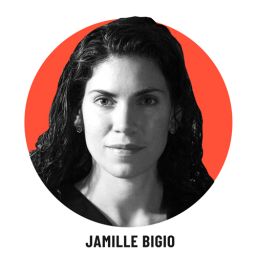Editor’s Note: Jamille Bigio is a senior fellow for women and foreign policy at the Council on Foreign Relations. The opinions expressed in this commentary are her own.

At her food stall in the largest open-air market in Lagos, Nigeria, Amaka Charles regularly checks her cell phone for her bank account balance. She is saving for her daughter’s school fees and dreaming of a loan to expand her business beyond crayfish.
Every day, she passes her few dollars of profit to Celestina, the bank agent who roams the market to collect vendors’ deposits. Charles calls if Celestina is late — she does not want to leave without trading her profit for the “bing” her cell phone makes each time her latest deposit is received.
Before she opened her BETA account with Diamond Bank, Charles stashed her cash in a drawer or entrusted it to an informal collector who, as part of a traditional neighborhood savings program, kept a tally of vendors’ savings in a little notebook. Neither method was especially reliable or secure — Charles often feared the collector would run away with her money. Now, with Celestina and the BETA savings account, she watches her daughter’s backpack bob on her way to school and plans for the future.
Access to financial services like bank accounts and digital payments can change the lives of women like Charles by allowing them to invest in their families’ health and education, borrow to grow their business, and build a cushion to better manage emergencies. Such access can improve women’s earning potential, help them escape poverty, and reduce inequality across the globe.
Yet close to one billion women around the world have no access to savings, credit or insurance, according to the World Bank’s Global Findex report. And even as the number of people opening bank accounts increases globally, the gap between male and female account holders in developing countries has stubbornly remained for nearly a decade. In Nigeria, 24% fewer women own bank accounts than men; in Bangladesh, it’s 29%. But in India, the groundbreaking digital national identification system helped reduce the gender gap between account holders from 20% in 2014 to just 6% in 2017.
Better access to financial services matters not just to women and their families, but also to economies. With greater financial inclusion, women are better able to realize their economic potential, and the gains can be staggering. The McKinsey Global Institute estimates that $12 trillion could be added to global annual gross domestic product (GDP) by 2025 simply by leveling the playing field between women and men at work.
Banks benefit, too, and more of them are recognizing that women are a promising and largely untapped client base that can fuel business growth. Even low-income women save 10% to 15% of their earnings, and their balances do not fluctuate as much as men’s — a consistency valued by banks.
The business case has convinced some banks to invest in products developed for and marketed to women. Since mobility and time constraints keep Amaka Charles and other Nigerian traders out of bank branches, Diamond Bank sends agents directly to the marketplace, using digital tools in place of traditional branch services. And because a recent central bank reform in Nigeria loosened account requirements, women can open an account without identification, signatures or forms. According to Diamond Bank, it now has more female customers than ever before: nearly 40% of the 600,000 BETA savings account clients are female, compared to 25% of its overall customers.
Vietnam’s Maritime Bank hopes to have similar success with its new products. Recognizing that there are millions more Vietnamese women working in the labor force than have bank accounts, the bank developed new product bundles for different customer segments identified by the nonprofit Women’s World Banking. These include home-based business owners who prize convenience, market traders who want access to loans and business training, and factory workers who want help managing their finances.
The next financial inclusion frontier is in rural areas far from bank branches. As banks shift their gaze to the rural millions without savings accounts, a simple solution is already in customers’ hands — their mobile phones. The potential gains are enormous: Mobile money paid off in Kenya, where banks and telecommunications companies expanded rapidly to keep up with demand for mobile banking services while nearly 200,000 households were lifted out of poverty.
In Tanzania, M-Pawa customers can open and use a Commercial Bank of Africa-affiliated account with just a cell phone and a registered Vodacom SIM card. They find an agent (many double as shopkeepers) to deposit their cash or collect their micro loan. Women with access to M-Pawa saved three times more money weekly than women with no access, according to a Center for Global Development study. When access was combined with business training, they saved five times more money weekly and were more likely to open a second business, increasing their overall profits. They were also more likely to report feeling happy and empowered.
Access to a bank account is transforming women’s lives and boosting economies from Nigeria to Tanzania to Vietnam. Close to a billion women around the world can, if given the chance — and the financial services — contribute to their families’ prosperity and their countries’ growth.




